If you want to admire bright colors even in winter, then you need to purchase an anthurium. With careful care, it is able to bloom at home all year round, in addition, some varieties have very beautiful, green leaves.
Content
What does a flower look like
Anthurium comes from South America, where it grows in natural conditions. Locals call it “fire flower” or “flamingo flower”, in our country it is better known as “male happiness”, it is believed that it brings prosperity to the house.
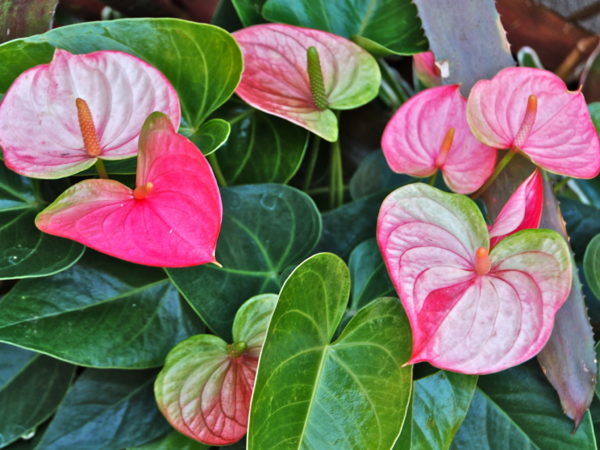
The plant has colorful, green leaves that shine so much that it feels like they are waxed. The most popular variety, anthurium andre, most often has a veil of red, white, pink, sometimes violet is found, their middle is decorated with an inflorescence-cob of a soft yellow hue.
The maximum growth of the plant is 30-40 centimeters, in addition, it has a pleasant smell. Florists are very fond of this flower because in cut form it can stand without losing its appearance for more than a month.
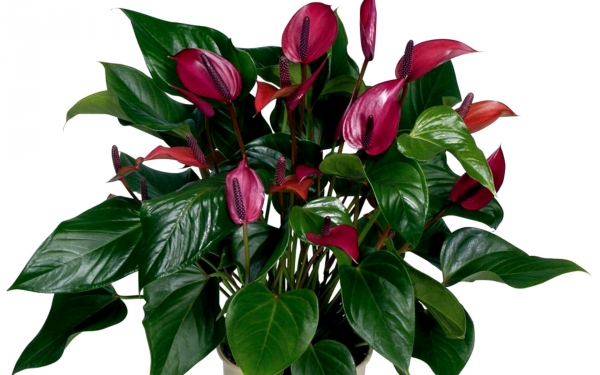
At the moment, breeders have bred many varieties of anthurium that have a non-standard color and leaf shape. In Colombia, it is customary to give this flower to the newlyweds for a wedding, by the way, he has a couple, this is spathiphyllum, which is popularly called “feminine happiness, it has a more tender and modest appearance.
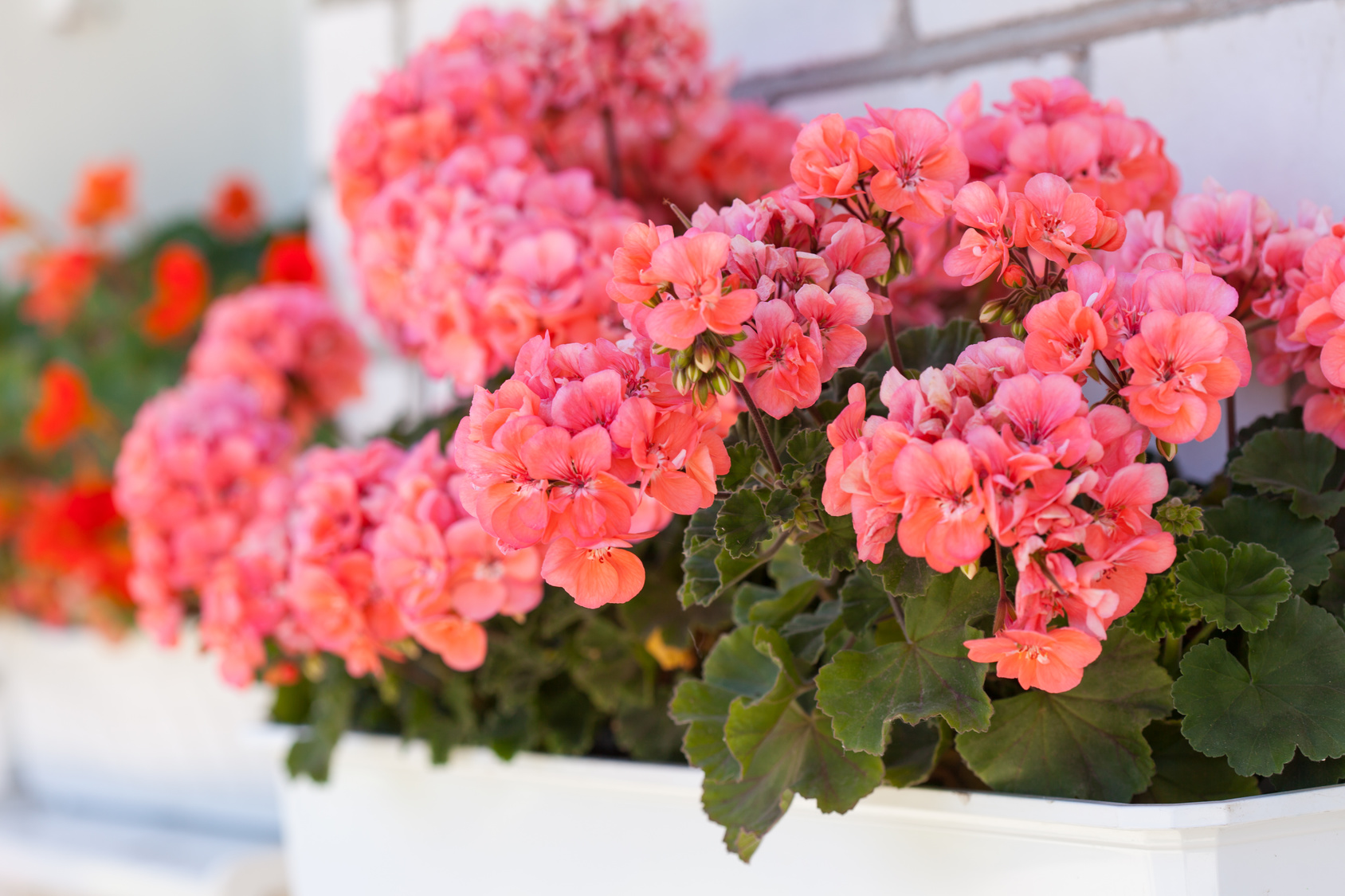 You may be interested in:
You may be interested in:If you separate anthurium and spathiphyllum at home, then they will maintain relationships in the family and protect love, in the photo you can see how harmoniously they look together.
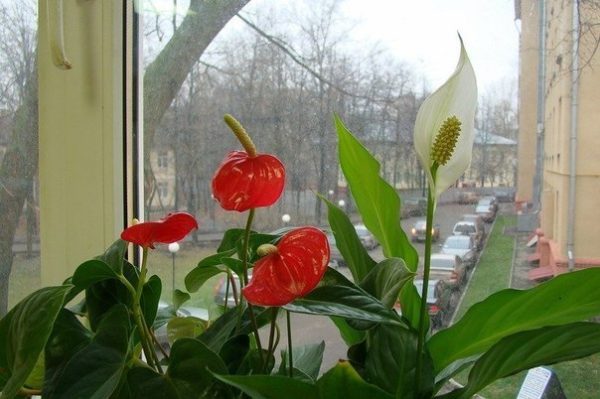
How to care for anthurium
Most often, it is not only the flower itself that gives pleasure to a person, but his care, because at the same time the best qualities of his nature are manifested. Anthurium is not too demanding, however, some of the subtleties of caring for it must be known.
Lighting
Anthurium loves diffused lighting, it is impossible that direct rays fall on the leaves. Despite the fact that the plant is shade-tolerant, in a too dark room it will not grow well. Therefore, the northern windows are not suitable for him, but the western and eastern sides will become ideal.
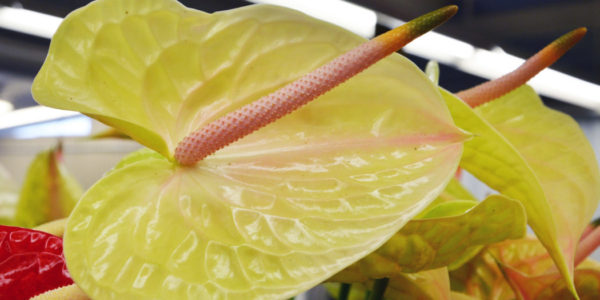
Temperature
In spring and summer, a temperature of 25 degrees is favorable for the flower. If it falls below 20, then the flower may become sick. But in winter, he feels great at 17 degrees. Many varieties do not like drafts and sudden changes in temperature, so its decrease should occur smoothly. It is also desirable that the plant is away from heating batteries.
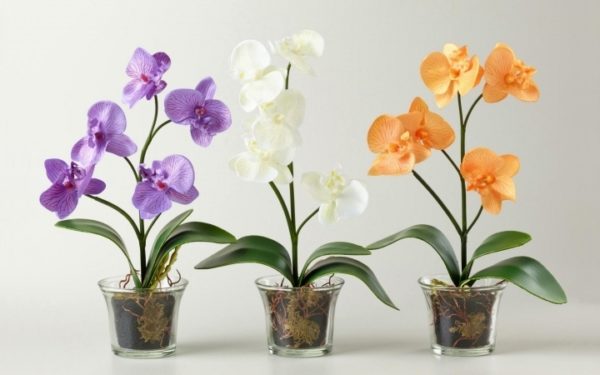 You may be interested in:
You may be interested in:Humidity
In modern apartments, almost ideal conditions are created for this flower, but moisture will be lacking.Therefore, it is necessary to purchase an air humidifier; instead, you can put the anthurium on a tray with wet sand or expanded clay. And also it is necessary to spray the air around the flower, while making sure that water does not fall on the leaves, because it will form ugly stains.
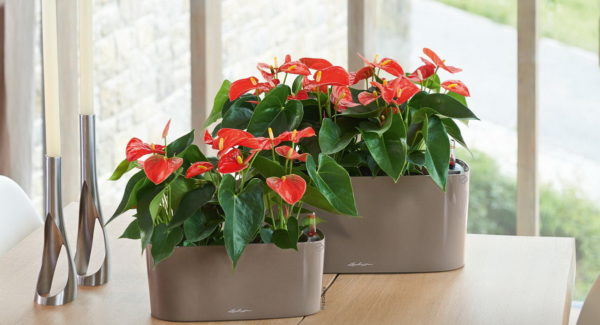
Once a week, wipe the leaves with a damp cloth. Sometimes you can put a pot in the bathroom and water it from the shower, but at the same time make sure that water does not fall on the flowers. After the procedure, wipe the leaves dry with a paper towel.
Watering
It is necessary to water the anthurium abundantly, but only after the upper soil dries. Water must be poured onto the ground and make sure that it does not fall on the plant itself. In winter, it is enough to water once a week, in summer more often. The liquid must be poured in advance in a special container so that it heats up and settles. You can soften the water by adding a little citric acid to it.
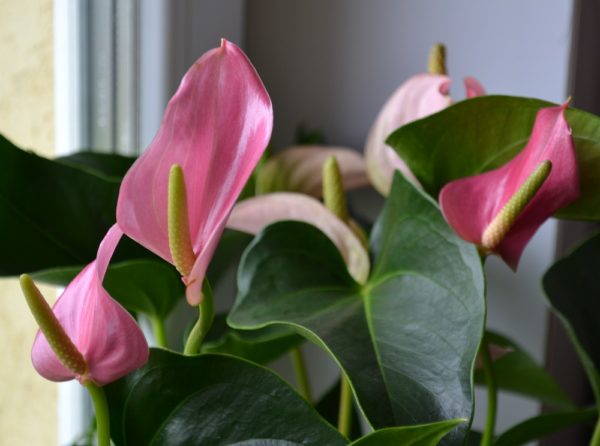
Top dressing
During the growth of anthurium and its flowering, it is necessary to feed it twice a month. To do this, use fertilizers for aroid plants, while reducing the dose indicated on the sachet by half. If in winter the flower is in a state of sleep, then it is not necessary to feed it, but only occasionally water it.
How is the reproduction of anthurium
If the flower is in one copy, then it is better to take care of its propagation in advance, in case the flower dies.
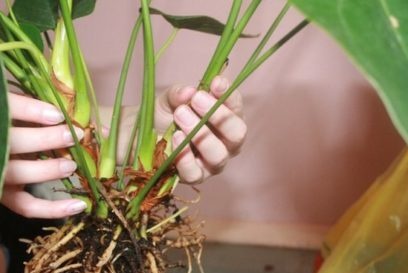
At home, this can be done in several ways:
- propagation by cuttings;
- division of the mother bush;
- using lateral processes;
- rooting a leaf.
You can grow a flower from seeds, but this is a long process, usually breeders use it.
Propagation by cuttings
In an apartment, cuttings take root well, if certain rules are observed, the cuttings must be from a healthy plant, have a growth point. Having cut the cuttings, it is necessary to let them lie down a bit so that the cut place becomes rougher, this will further protect the plant from decay.
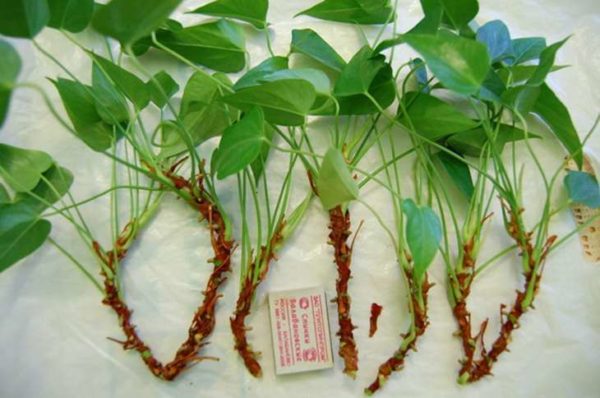
Reproduction can be done in several ways:
- Place the handle in boiled and cooled water, while putting a piece of charcoal on the bottom of the container. As soon as the first shoots appear, immediately place the stalk in the ground.
- You can plant the cuttings in a substrate, which consists of peat, perlite and sand in equal quantities. Cover the plant with a glass jar. Within three weeks, it must take root.
- If you plant a stalk in moss, then you can use a plastic bag for this.
This is the most common breeding method, but there are others as well.
 You may be interested in:
You may be interested in:Bush division
This method can be used if the flower has grown greatly, it is better to carry out such reproduction in the spring. Anthurium transplantation is also an indispensable attribute in caring for a plant at home. Such a procedure may be needed if the container has already become cramped or there are signs of root disease.
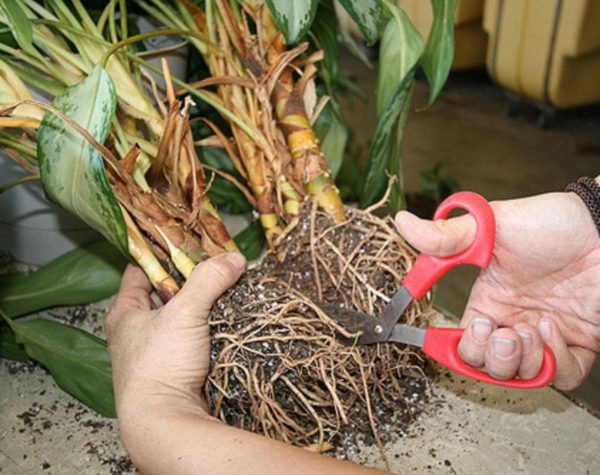
Pulling the plant out of the pot, it will be necessary to shake off the ground and separate it by hand, since the roots are quite fragile, then plant each part in a separate pot.
Propagation by offspring
This method is also used when transplanting anthurium, so as not to damage the root system, you can simply separate the side shoots. The flower is then planted back in the pot, and the sprout is placed in a separate container, preferably in the greenhouse. Siblings must be constantly sprayed and watered with warm water. Somewhere, in a month they can be planted in separate pots.
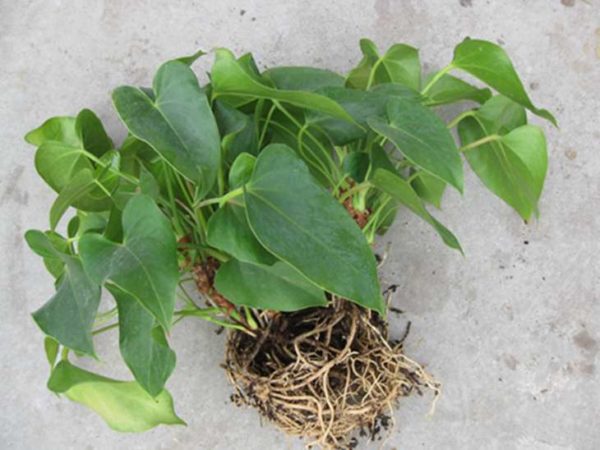
Leaf rooting
With this method, it is better to cut the sheet with the petiole, while the sheet itself must be rolled up into a tube and secured with an elastic band.Then we plant it in the soil, so that 1/3 of it remains on the surface. The plant will take root better if you cover it with a jar or a plastic bag.
What to do immediately after buying a plant
First you need to carefully examine the flower to determine if it has any diseases. Many of them cannot be seen with the naked eye, so you need to take a magnifying glass. If pests are found, it is necessary to treat the flower with insecticidal preparations. Even if anthurium had no diseases, it is necessary to hold it for two weeks separately from other flowers, and even better a month. During this time, it is impossible for direct sunlight to fall on the flower, it is better to use artificial lighting.
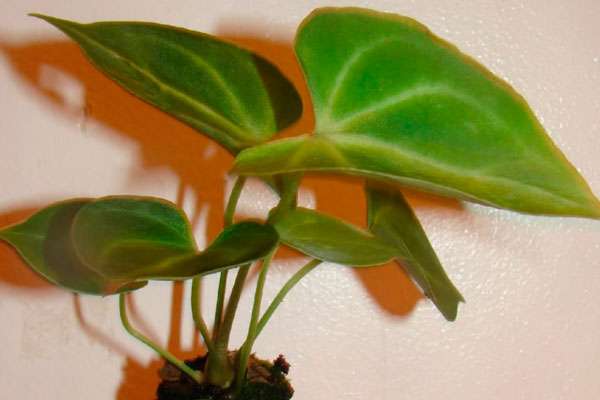
After the purchase, you may need an anthurium transplant. To do this, take the plant by the trunk and carefully pull it to pull out of the pot along with the roots, a transplant is necessary if:
- the earth smells unpleasant;
- visible signs of rotting roots;
- a lot of dry roots;
- no drainage;
- insects were found in the soil;
- there are swellings on the roots.
Quite often, flowers are sold in acidic soil, it can be determined by color, usually it is red and has a fibrous structure. If such reasons are not found, it is necessary to return the anthurium back to the pot.
Anthurium transplant
Caring for anthurium at home, you must constantly monitor the condition of the flower so as not to miss the moment when a transplant may be needed. Apart from the above cases, young plants need to be replanted once a year, and adult flowers once every three years.
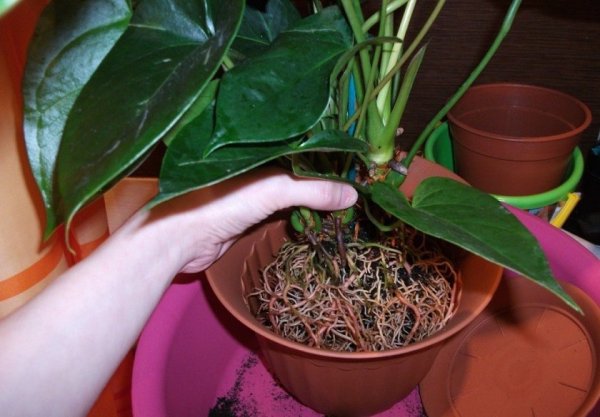
First you need to choose the right flower capacity, it should be spacious. However, the pot should not be much larger than the previous one, otherwise it will take a long time to wait for flowering. Anthurium will not give a new cover until it fills all the free space with its roots.
The material does not matter much, it can be plastic, glass. But if the pot is made of clay, then it is necessary that it be covered with glaze on both sides, because the roots can grow into clay.
The soil of the flower should be quite light, while the acidity should vary from 5.5 to 6. The ideal soil consists of the following elements:
- peat without impurities;
- sand;
- sheet earth;
- coniferous tree bark.
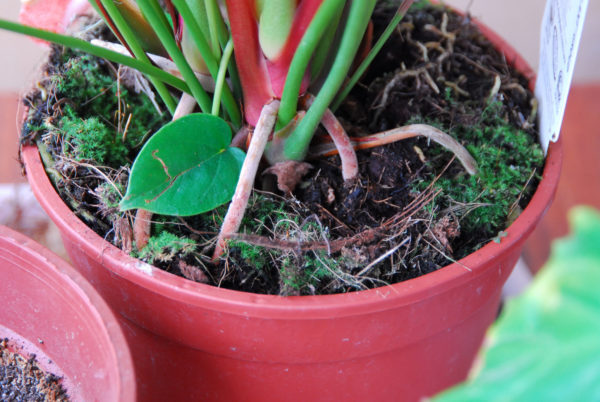
In this case, the bark must first be crushed and boiled, you can still add charcoal, this will destroy the parasites in the soil. Perlite and sphagnum will make the soil more loose.
If you use the land for orchids, then it will have to be fed more often than usual. You can take the land from the garden, but first it must be roasted in the oven.
Transplant after purchase
Take a new pot and pour a layer of drainage first, pull out the plant, holding on to the base, and place it in a new pot. To make it easier to take it out, you must first water the flower, then pour the soil, lightly tamping it.
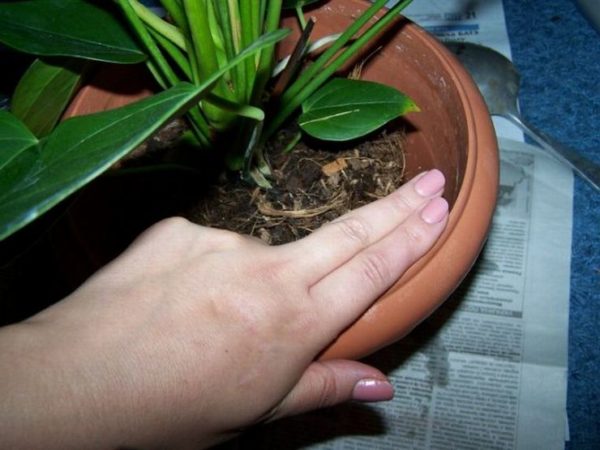
If the transplant is carried out in order to replace the soil, then first you need to put the flower in a container of water to remove all the old soil from the roots.
Transplant during flowering
Although most florists do not recommend transplanting during flowering, because it is a certain stress for the plant, and it can lose flowers. But anthurium perfectly tolerates this procedure even during flowering, the main thing is not to damage the roots.
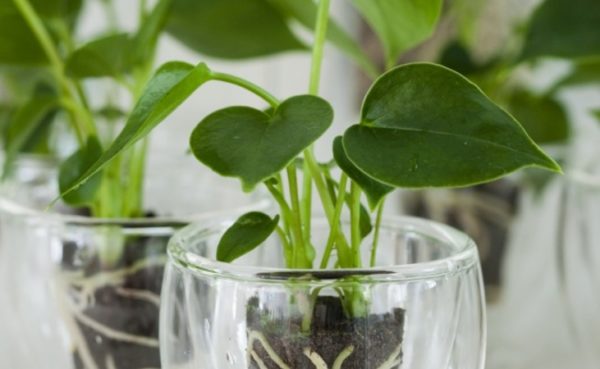
Varieties of Anthurium
In the world there are more than 1,500 species of this plant, they are bred not only as a room flower, but also for decoration of bouquets. Consider the most famous varieties.
Anthurium Andre
Under natural conditions, this shrub reaches up to 1 meter in height, and when grown in pots, the limit is 60 cm.
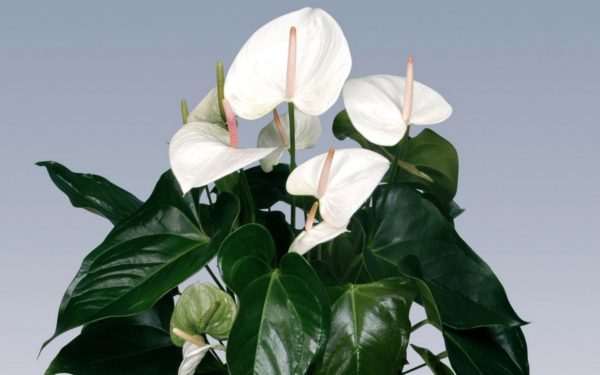
The leaves of the flower have a dark green hue, the surface is waxy and glistens in the sun. The inflorescence is collected in one ear and has a yellow color. Leaf length reaches 60 cm, the plant is characterized by long flowering. In nature, the anthurium coverlet is red, but thanks to breeders you can now meet a plant of various colors.
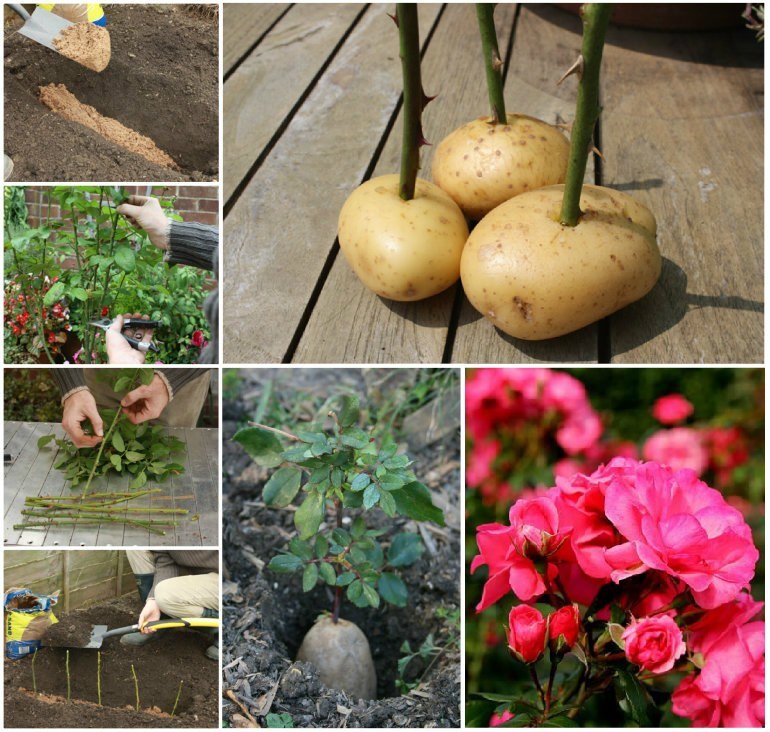 You may be interested in:
You may be interested in:Anthurium Scherzer
This variety is distinguished by a long, curved inflorescence covered with pimples. The plant has a shortened trunk and dense leaves with a matte shade.
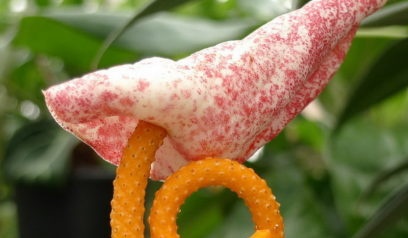
On some varieties, on the leaves you can see a bitmap. The height of the flower can be different, there are dwarf ones that do not exceed 10 cm.
Anthurium Baker
This epiphyte has elongated, fleshy leaves, the ends of which are decorated with a brown pattern. Inflorescences of beige or green tones, when flowering occurs, picturesque, red fruits appear on it.
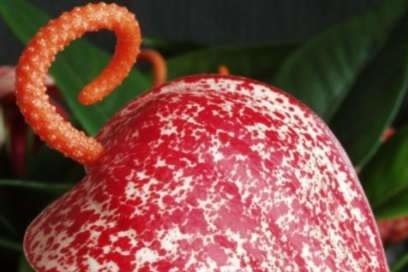
Anthurium Crystal
Unlike his brothers, he does not have a picturesque bedspread, but in the presence of beautiful leaves with silver streaks. Peduncle grows up to 40 cm and has a delicate, creamy hue.
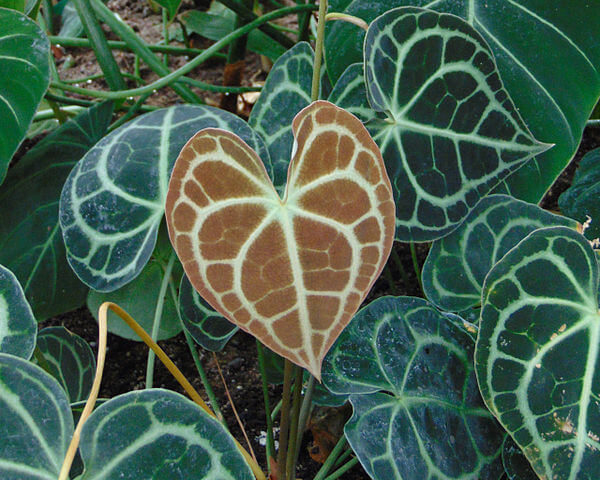
Anthurium disease and its treatment
Anthurium, this beautiful, southern plant, without proper care, is prone to diseases, with the slightest signs of a change in the appearance of the flower, it is necessary to begin its treatment. Diseases can occur if you do not follow the requirements of agricultural technology, the infection can be introduced by an insect.
Quite often, there is such a problem that the leaves of the anthurium turn yellow, this can only happen if the plant is improperly maintained at home.
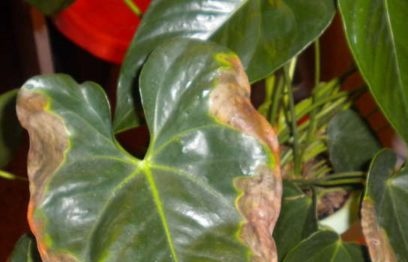
The causes of yellowing may be as follows:
- chlorosis;
- burn from direct sunlight;
- the leaves froze.
First, it is worth checking the watering, maybe the plant has little liquid or it is very hard. Most likely, top dressing is necessary or it is necessary to increase the amount of lighting. If the leaf veins are green and the leaf itself is yellow, then these are signs of chlorosis, then it is necessary to start spraying the bush with iron chelate or an algae extract. If there was a sunburn, then the leaves twist, so you need to rearrange the flower in another place.
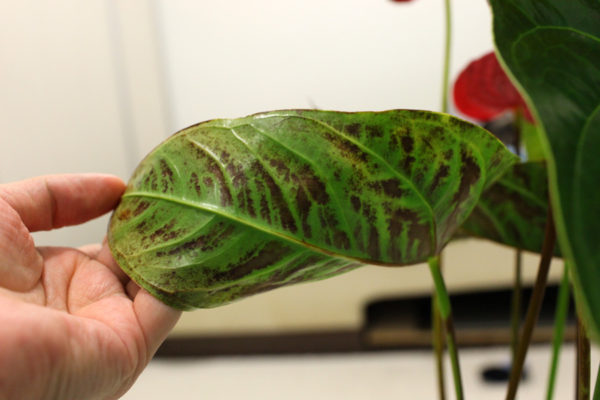
Quite often you can hear such a question, why do the leaves of Anthurium dry, although they try to observe proper care of the plant at home. Most likely, this happened from insufficient watering, the presence of drafts, maybe a little humidity in the room. In this case, it is necessary to remove all the damaged leaves, and sprinkle the affected areas with wood ash or cinnamon powder.
If brown spots appeared on the leaves, then this indicates too abundant watering, blackening of the leaves occurs due to improper transplantation.
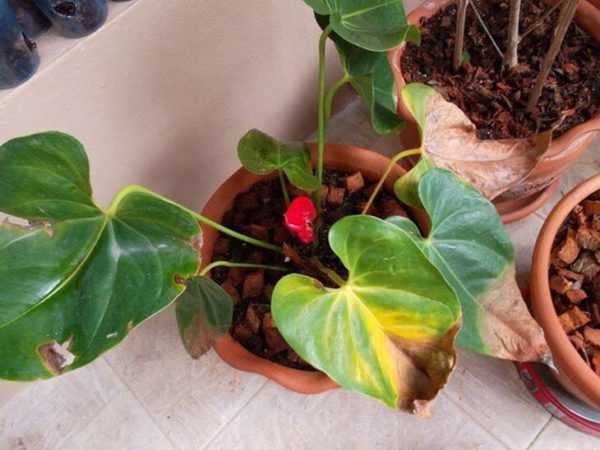
In addition to improper care, plants can catch an infection from the outside:
- Septoria;
- anthracnose;
- Fusarium wilt;
- rust.
With septoria, the leaves become brown and dry, it is necessary to treat the anthurium with fungicides containing copper.
Anthracnose is also popularly called powdery mildew, with this disease the leaves become dark brown, and black dots appear in the center. At the first signs of the disease, you need to remove all damaged leaves, change the ground, disinfect the roots, reduce watering.
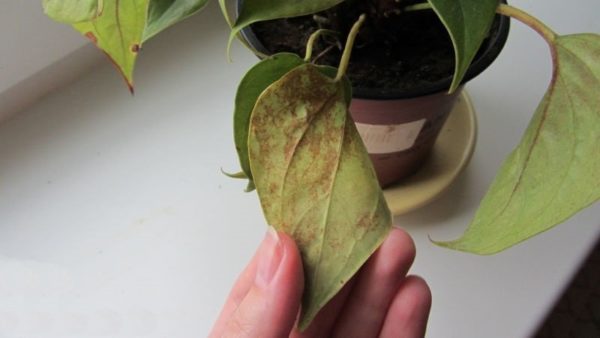
If the fungus has spread greatly, then it is necessary to use fungicides, it is advisable to choose not very toxic, treatment with Bordeaux liquid helps. If the plant could not be cured, then it must be burned, and the pot should be calcined or discarded.
When rust leaves are covered with orange tubercles, such a flower should be wiped with a fungicide solution, but do not use spraying, otherwise you can infect the remaining leaves.
With fusarium wilting, the entire bush begins to wither, while the flowers bend unnaturally. In such a situation, it is necessary to treat the earth with glyocladine, while removing all damaged parts.
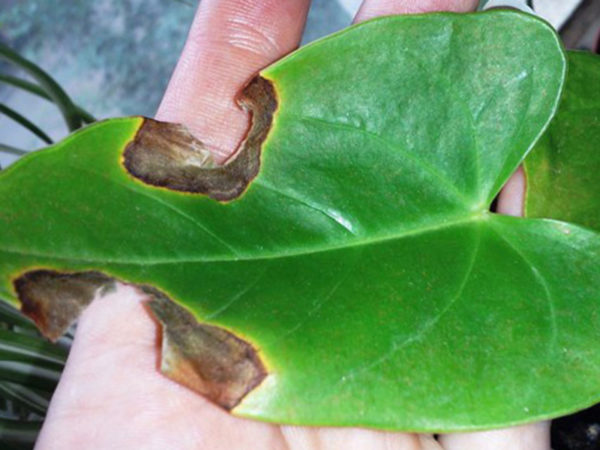
Parasite diseases
It is quite difficult to protect yourself from such diseases, the most dangerous are:
- aphid;
- scale shield;
- spider mite;
- thrips.
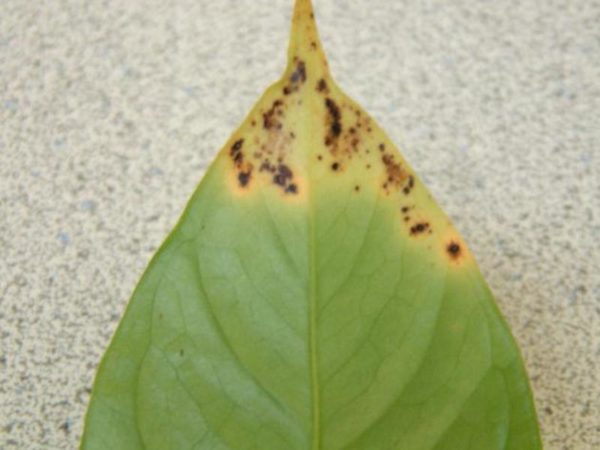
The latter, it is quite difficult to determine if black dots appeared on the back of the sheet, then these are them. Such a plant must be treated with insecticidal drugs, in order to prevent more often ventilate the room. With a spider mite, you should wipe the leaves with a solution of laundry soap.
Anthurium diseases are easier to prevent than to treat, so you need to constantly carefully examine the plant. With proper care and preventive measures, anthurium will grow well and delight with its flowering.




 Sow in the ground, without seedlings: 10 beautiful and unpretentious flowers
Sow in the ground, without seedlings: 10 beautiful and unpretentious flowers Platicodon planting and outdoor care
Platicodon planting and outdoor care Hosta - planting and care in the open ground in the Urals
Hosta - planting and care in the open ground in the Urals Oleander - care and growing at home
Oleander - care and growing at home